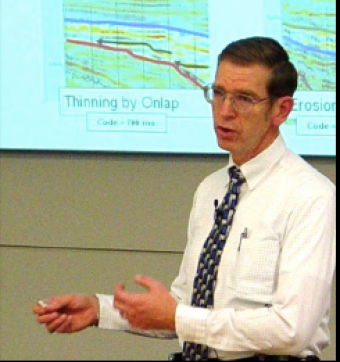Date: November 1, 2016 40min Advanced
In exploration, we want to know, to the best of our ability, if there will be good quality reservoir rock where we propose to drill. This means two (2) things: (1) reservoir rocks are present, and (2) reservoir properties will be good enough to produce HCs. Our ultimate goal is to know how much HC is in the potential reservoir and what portion we can produce, the estimated ultimate recovery (EUR).
Divide the class time into three (3) segments: (1) review the previous exercise, (2) introduction the lecture material, and (3) introduce the exercise presented here. The review of the previous exercise contains six (6) slides, and will take ~10 minutes to explain. The lecture contains twelve (12) slides, and will take ~20 minutes to explain. The introduction to the exercise contains five (5) slides, and will take ~10 minutes to explain.
In this exercise, the students will perform a series of calculations for “columns” that divide the reservoir on a seismic line into ½ kilometer wide cells. The reservoir is also subdivided into three, equal-thickness units. There are eighteen (18) rows on the computation sheet, with most of the values already filled in. Students have to fill in row 1 for columns I through T and all the other rows just for columns I, J and K. There is a scale at the bottom of the computation sheet to measure the thickness of the reservoir in I, J and K. Net-to-Gross (N:G) and porosity (Φ) are assigned based on the interpreted EODs for the upper, middle and lower zones, as given in rows 4, 5 and 6. The students work to get the HC pore volume in each cell/column, which goes in row 18. Then they sum all the values in row 18 to get a cross-sectional HC area (step 12). Steps 13 and 14 use some over-simplifications to get a volume of oil that could be produced. This exercise should take ~30 minutes.
At the end of this lesson, students should be able to:

This course, based on teaching material from Dr. Fred Schroeder (formerly of Exxon/ExxonMobil), reflects on the geology and geophysics basics for the petroleum industry. General geology and basic geophysics are not required, but helpful with the material.
We encourage the reuse and dissemination of the material on this site as long as attribution is retained. To this end the material on this site, unless otherwise noted, is offered under Creative Commons Attribution (CC BY 4.0) license